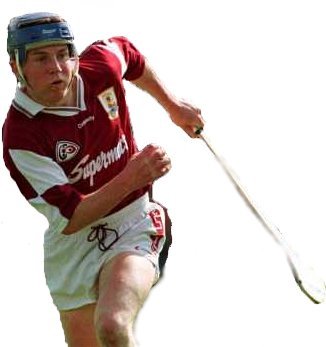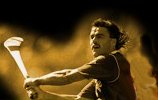

Out of a panel of twenty one players, fifteen take the field to play. The positions include one goalkeeper, six backs, two midfielders and six forwards. Up to three substitutes may be called by either team.
The field dimensions are of between 140 and 160 yards in length and 84 and 100 yards in width. Either end of the field will have a H-frame goal, fourteen yards wide with a crossbar eight foot from the ground.
A goal is scored if the ball passes between the posts and under the crossbar. One goal is worth three points. Goals are signalled by raising a green flag, placed to the left of the goal. A point is scored if the ball passes between the posts and over the crossbar. Points are signalled by raising a white flag. A game consists of two 35 minute halves.
A game is officiated by one referee, two linesmen and four umpires.
The sliotar may be carried in the hand for up to four steps or indefinitely on the stick and may be kicked, palmed or hurled but never on any account thrown or picked up from the field by hand.
A handpass is permitted, but a clear striking motion must be visible to the referee.
If the ball passes over either end line, having hit a defending player last, a 65 yard free is awarded to the attacking team.
When the sliotar goes over the end line as it was struck wide or between the uprights, the game is restarted with a strike from the six yard or twenty-one yard lines.
No pushing, jersey pulling, kicking, hitting or otherwise abusing of opponents will be tolerated and persistent offenders may be cautioned, booked or sent off in which case a two week suspension would be imposed.
A player may shoulder an opponent to unbalance him but should never use his hip or elbow and must keep one foot on the ground during the challenge.
A variety of frees and penalties may be awarded for infractions in and around the goal. Frees will be hit from the ground on the fourteen yard line. Penalties are also hit from the ground but may only be defended by the goalkeeper and two defenders in the goal mouth.
The All-Ireland Championship is the biggest hurling championship in Ireland, held in Croke Park. Teams representing each county compete for the McCarthy Cup. The teams compete within their own province. One team from each province advances to the semi-finals and finals. A recent hurling reform is the addition of two matches, All-Ireland quarter-finals, which clears the way for two separate semi-finals. Guinness Ireland has commited to sponsoring these until 1999.
Hurling Organizations
Current Hurling Results

The sport is Ireland's oldest, and is an integral part of the culture and hertiage of the nation. Today it is the third most popular sport in Ireland, played by nearly 100,000 Irish people. It is the fastest ball sport in the world. Camogie is the women's verison of the sport, played according to the same basic rules with different shaped hurleys.

Hurling is an ancient Gaelic sport, developed in pre-Christian times. The earliest written record of the game is contained in the Brehon Laws of the fifth century. In the eighteenth century, the game became organised, with teams lined out in set positions, and a strict code of honour to control conduct. Hurling lost much support during the Great Famine. The first standardized rules for hurling were established in 1884 by the Gaelic Athletic Association, which led to a revival of the sport. The first Senior Hurling Final was played 1887. The GAA has become the largest sporting organisation in Ireland. Today, the dominant teams are from Leinster and Munster. Cork has won the most championships, with twenty-seven.

CLARE
1997 All-Ireland Champions

The ash stick used in the sport is a hurley. These can range from 30 to 37 inches in length. The ball used is called a sliotar. This is traditionally moss wrapped in pig-skin. Today it is a leather skinned ball weighing 40 ounces.
The Gaelic Athletic Association Official Website
The Unofficial Gaelic Athletic Association Website
F�ilte Sport
Irish Times SportsExtra
Radio Telef�s �ireann Aertel